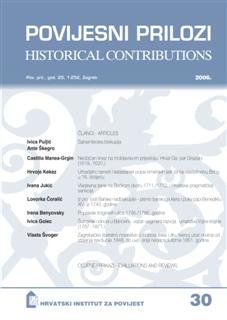Urbarijalni nameti i katastarski popis kmetskih selišta na vlastelinstvu Brlog u 18. stoljeću
Taxes and cadastre of serfs’ settlements in the manor of Brlog in the 18th century
Author(s): Hrvoje KekezSubject(s): History
Published by: Hrvatski institut za povijest
Keywords: Urbarium – feudal law; serfs’ homestead; cadastre; manor Brlog; Count Benevent Sigismund Petazzi; Maria Theresia
Summary/Abstract: The eighteenth century is period of significant social and economic changes, which have consequently led to the changes in relations between serfs and their landed gentry. Starting with “Urbarium” - feudal law adopted by Karl VI in the year 1737, then later Slavonian feudal law of Maria Theresia (1756), and finally Croatian feudal law from 1780, these feudal relationships have been structured in a regulated legal framework. With the Urbarium the sovereign for the first time interfered in these relations between serfs and feudal lords. By mere release of feudal law and through its provisions the ruler wanted to stop the transformation of the communal land and alteration of yeomen into the manorial domicile land. These feudal laws at first considerably improved the position of serfs, but later in some issues this position was deprived. The manor and the city of Brlog were settled on the west slopes of Žumberak, along the river Kupa, close to the fortified city of ozalj. During the most of the eighteenth century the city was ruled by noble family Petazzi. Count Benevent Sigismund Petazzi, who had owned the estate since the year 1740 and lived there until his death in 1785, aiming to modernize the manor and increase income, decided to regulate the obligations of the serfs and to draw the special, separate feudal laws for settlements within his manor. In order to write the law as best as possible count Petazzi created a questionnaire that should have given him a more precise review on the previous obligations of the serfs and their respective dues. The questionnaire was written in 1774 in the Croatian and latin language. According to the serfs statements it is possible to conclude that they were afraid that they will be obligated to pay more dues and taxes. According to the cadastre census of serfs‘ homesteads, accomplished in the years 1777 and 1778, the manor Brlog consisted of nine settlements. The serves‘ land, registered in the census, was classified in several different categories. Data on the size and type of the serfs‘ land indicate three main problems: fragmentation and dislocation of the land plots cultivated by the serfs, and further the disproportion in the size of their homesteads. These three problems caused that the modernization of the agricultural production in the manor Brlog was impossible. Count Petazzi prescribed the feudal laws for the each settlement in the manor of Brlog in 1778. These feudal laws were printed and bound in stiff covers, containing approximately fifteen pages. The part that was general and common for all the villages was printed in the Croatian language, and the part which referred to the separate provisions concerning the particular villages was in handwriting.The feudal laws precisely established the obligations of the serves towards master, and consequently there was no much space left for the agreements to be reached between the serfs and the manor. This feudal law legisla
Journal: Povijesni prilozi
- Issue Year: 2006
- Issue No: 30
- Page Range: 79-102
- Page Count: 24
- Language: Croatian

